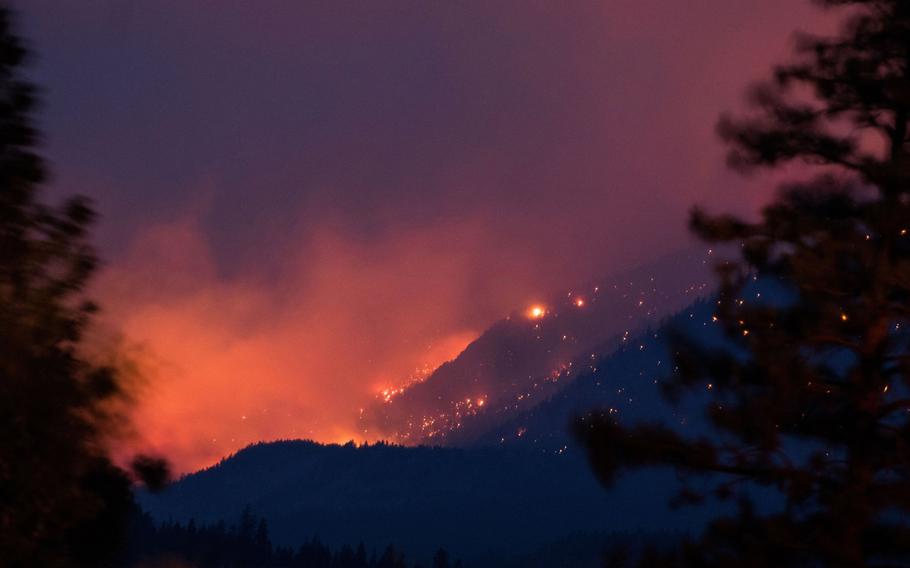
A wildfire burns above the Fraser River Valley near Lytton, British Columbia, Canada, on July 2, 2021. (James MacDonald/Bloomberg)
In the wake of the catastrophic Maui wildfires, fire risks are escalating in several parts of the United States, fueling fears that dangerous blazes could strike during late summer and fall.
While the 1.5 million acres burned nationally so far this year ranks as the least in the past decade, that number reveals little about how the rest of the fire season will play out.
Wildfires are on the upswing in several states. Texas has become a tinderbox because of weeks of extreme heat, with little relief in sight. Fire danger is high in the Pacific Northwest as a heat wave combines with wind and possibly lightning this week. Dry thunderstorms could ignite blazes in Northern California, kick-starting what has been a quiet fire season there so far.
"I'm not pessimistic, but neither do I feel like what we've had over the past couple months is necessarily indicative of the next several months," said Erica Fleishman, director of the Oregon Climate Change Research Institute at Oregon State University. "There are just too many wild cards both on the weather side of things and also on the ignition side of things."
Many spots face heightened wildfire risk in the coming weeks and months — from the West to the Deep South to the Upper Midwest, as well as Hawaii and Alaska, according to the National Interagency Fire Center.
Heat and fire danger in the Pacific Northwest
This week, a prolonged and intense heat wave is bearing down on the Pacific Northwest, with several days of record-breaking, triple-digit temperatures. Red-flag warnings are in effect through Tuesday for high fire danger along the Cascade range because of hot, dry and unstable conditions, while the National Weather Service in Portland is warning that "a combination of dry forest fuels, gusty winds, and low humidity" will cause rapid spread of new or existing fires. On Sunday night, evacuation orders were issued for the Lookout Fire burning east of Eugene, Ore.
Officials have pre-positioned firefighting resources anticipating a significant uptick in blazes.
Western Washington and Oregon have seen drought expand and deepen this summer, and Fleishman worries that the perceived wet winter out West may lead to complacency about fire season.
"We didn't get a deluge in most of the Pacific Northwest, and it's been dry since May in a lot of areas," she said.
The heat is also building into Northern California, where dry lightning could "result in a critical pattern bringing increased fire activity" this week, according to forecasters with the Northern California Geographic Area Coordination Center in Redding.
Texas and the Deep South
Texas has been baking under extreme temperatures for much of the summer, with several cities including Austin reporting their hottest July ever. As a result, vegetation is at or near record dryness and fires are intensifying, becoming a safety issue for both firefighters and the public.
"Our fire activity has accelerated in terms of the volume but also in terms of the types of fires that we're going to — they're becoming much more resistant to control," said Luke Kanclerz, a fire analyst with the Texas A&M Forest Service.
There is a particularly high-risk stretch from San Antonio north to Dallas, which has a high population density but also volatile timber and brush fuels.
The landscape is so parched that fires aren't requiring much wind to grow rapidly, Kanclerz said. Still, meteorologists are on alert for any incoming fire weather, including the threat of hurricanes.
In September 2011, amid an already bad fire season and record drought, Texas landed on the dry side of Tropical Storm Lee, and its winds whipped up the most destructive fire in state history. The Bastrop County Complex Fire southeast of Austin destroyed nearly 1,700 structures and killed two people.
"We are very much keeping an eye on any type of tropical system," Kanclerz said. "It's not just Texas — extreme heat is also impacting other southeastern states along the gulf. If we continue this hot and dry pattern and there is some kind of tropical system that just produces more wind on the landscape, there could be some significant fires that occur in parts of the southeastern U.S."
Will it be a dangerous autumn?
There are signs that trouble might linger into autumn in Hawaii, and along the West Coast, where strong dry winds begin to ramp up. The Upper Midwest is also an area of concern, given worsening drought and the region's history of autumn wildfire disasters in the late 1800s and early 1900s.
But rain can have a big impact on the trajectory of the fire season, and recent wet weather patterns have brought some relief to both the Southwest and Upper Midwest, among other areas.
"Is this a temporary relief or is it going to be longer-lasting so that they won't have to worry about fires into the fall? That's our question right now," said Jim Wallmann, a meteorologist with the National Interagency Fire Center.
In an era of worsening wildfires, the tragedy in Lahaina, Hawaii, proves that the tide can turn quickly in unexpected locations, especially when extreme fire weather strikes.
"The same factors are at play in a remarkable number of areas," Fleishman of Oregon State University said, noting the common themes among recent wildfire disasters around the globe: heat, drought, highly flammable vegetation, and large concentrations of people who don't have many ways to evacuate. "So many of the threats to human lives and to structures are similar in all of the locations that are burning."